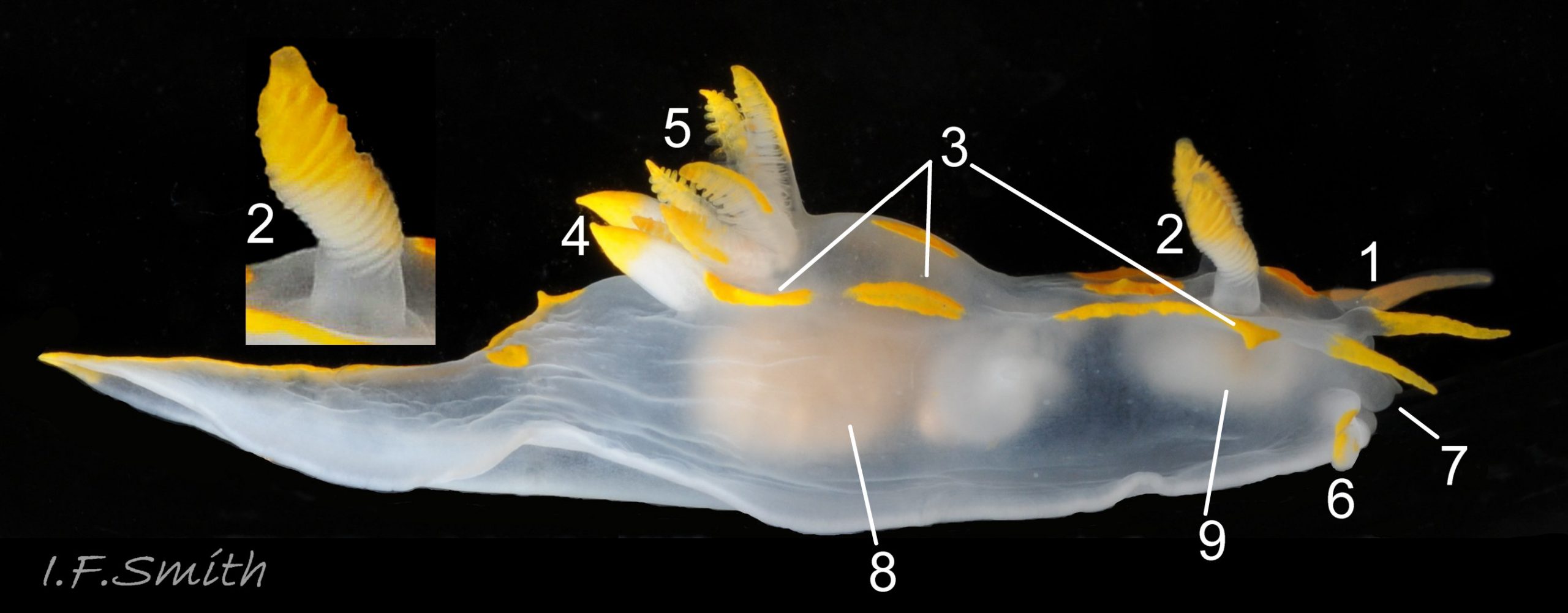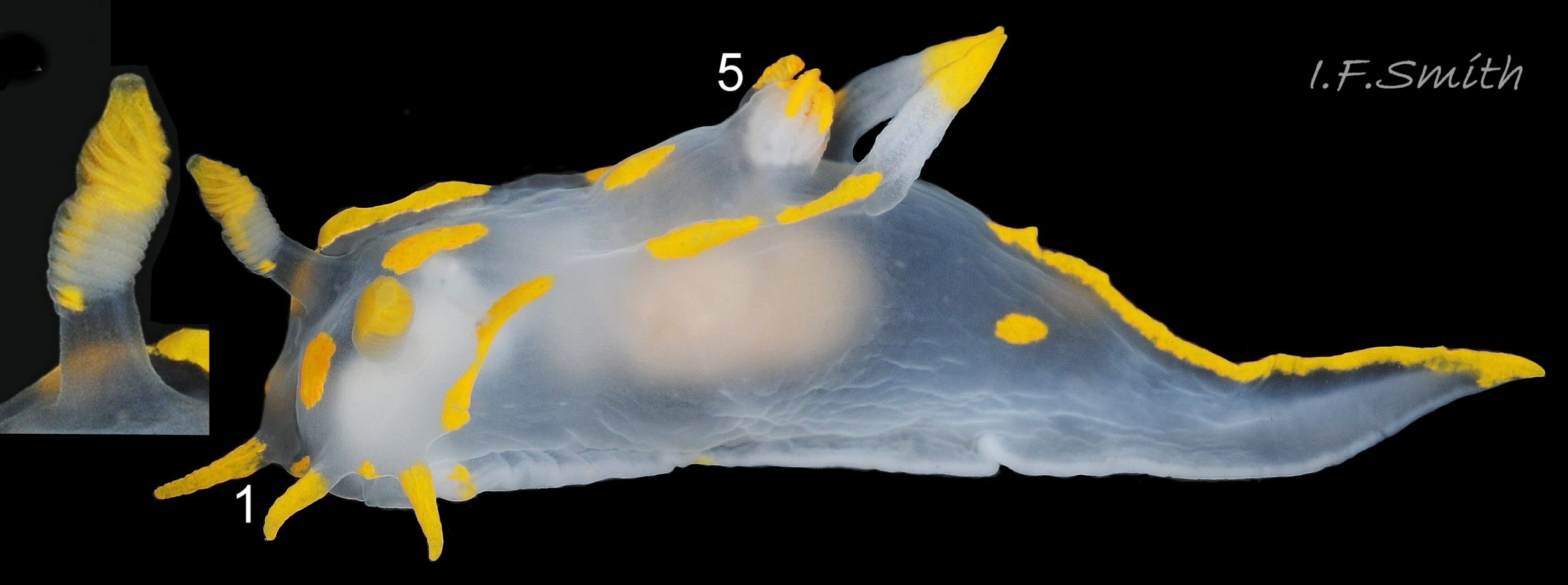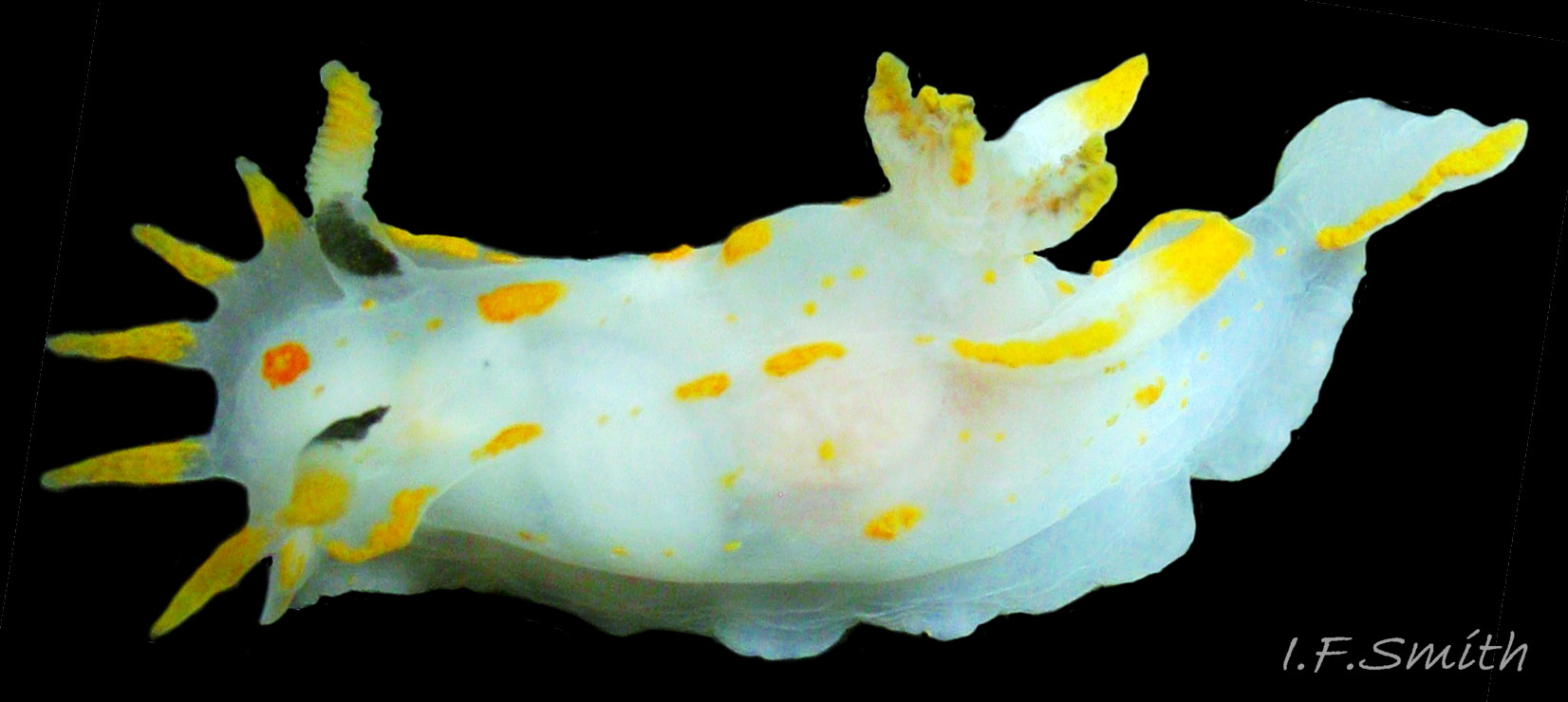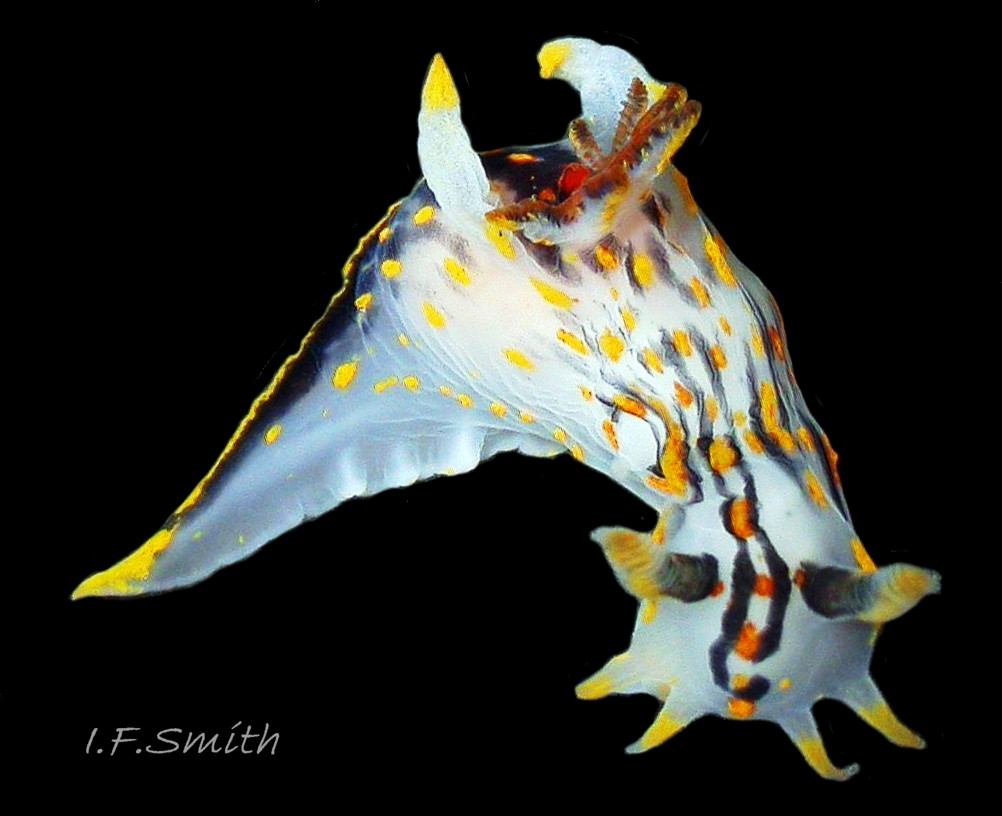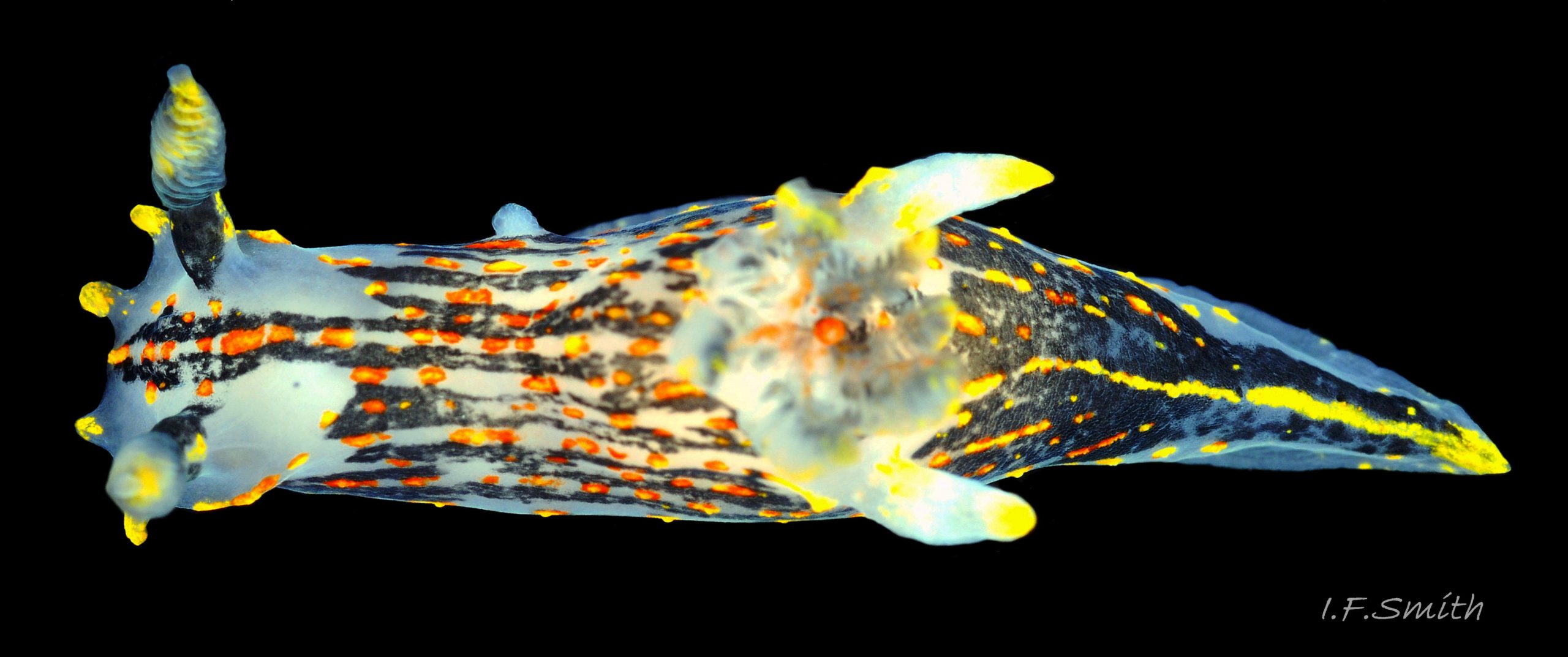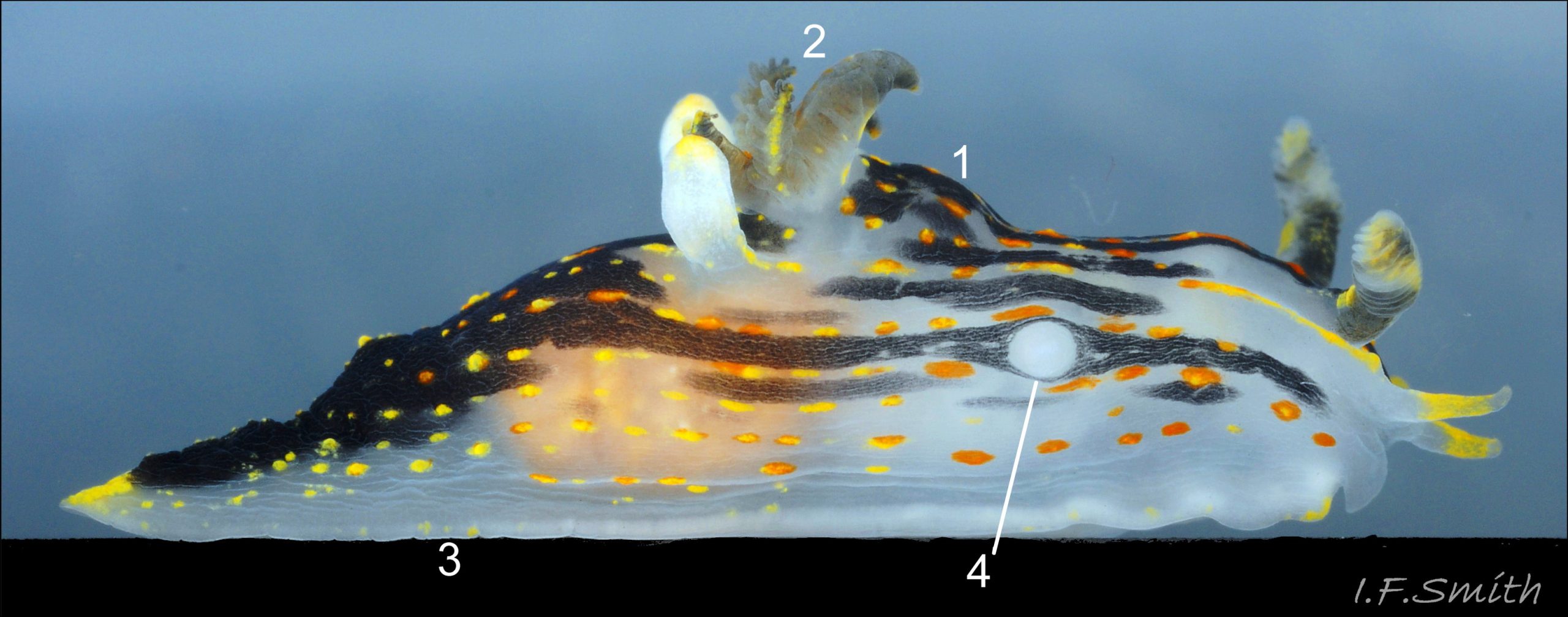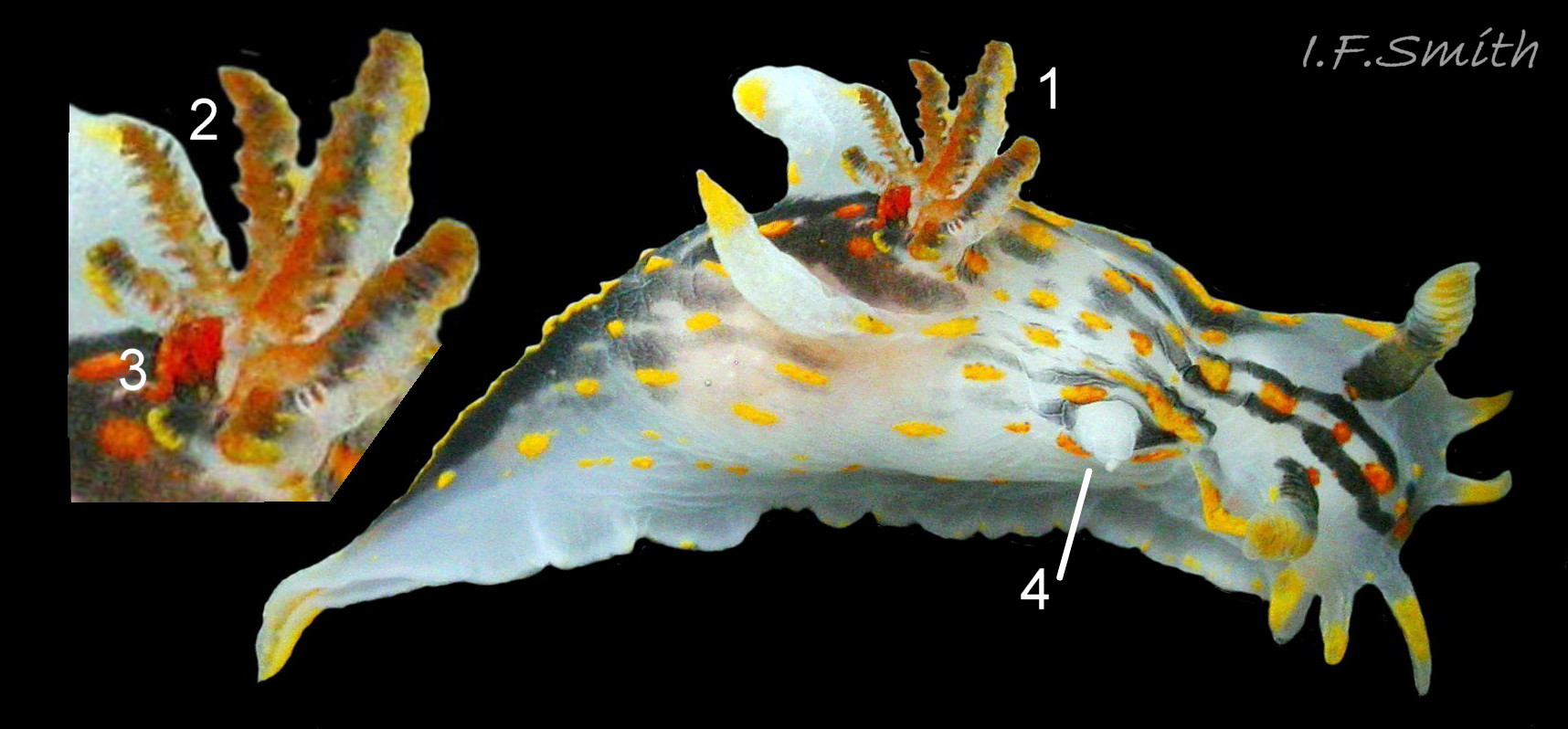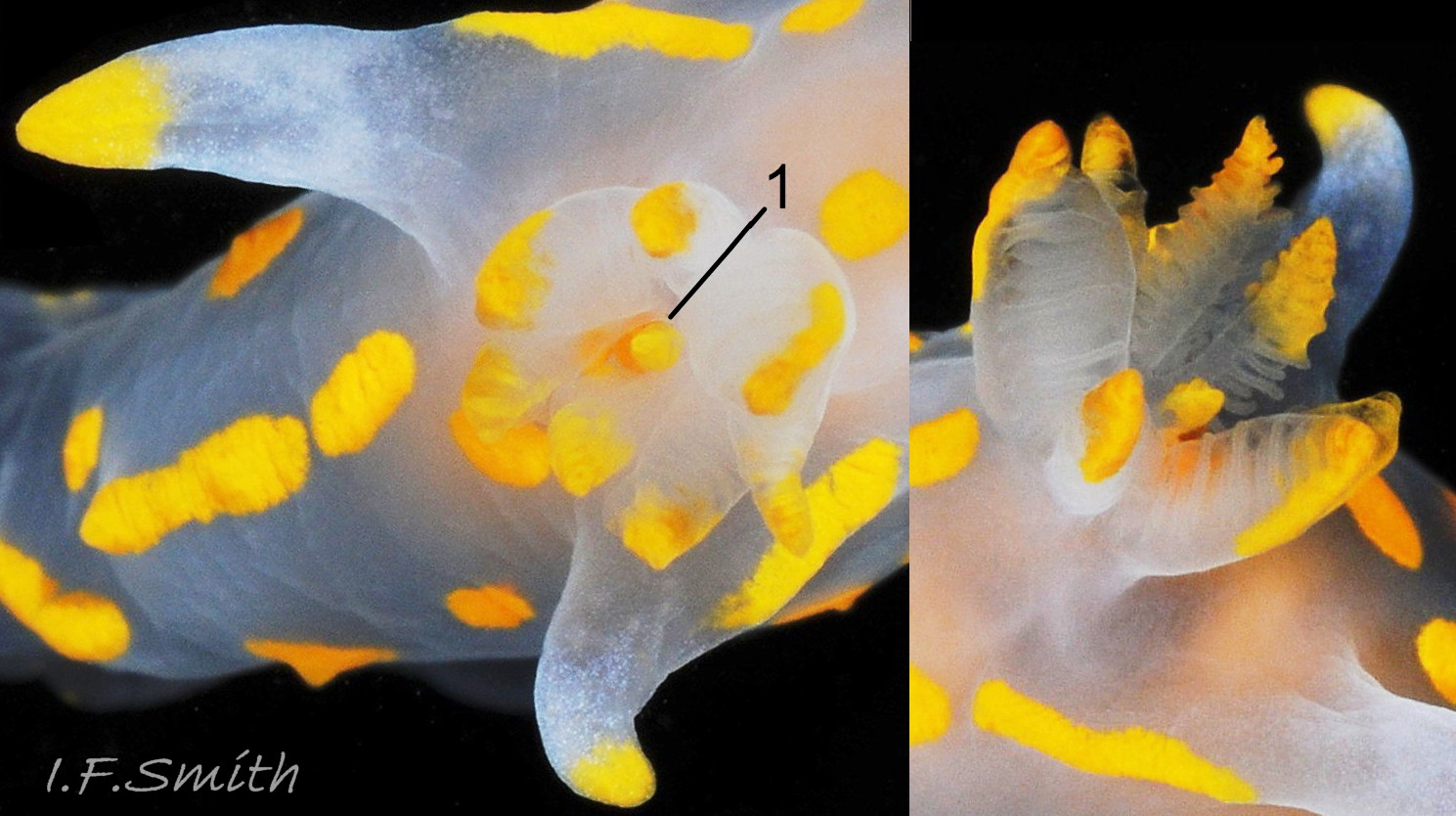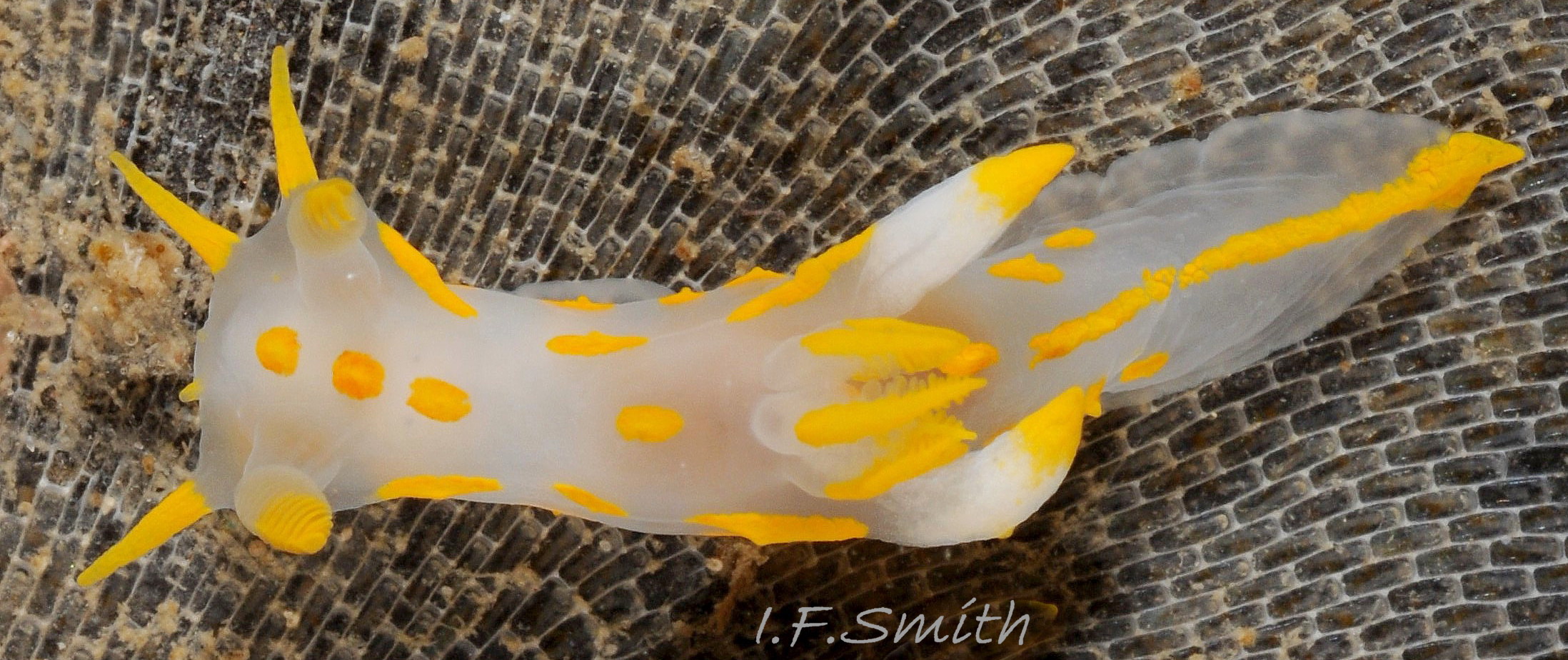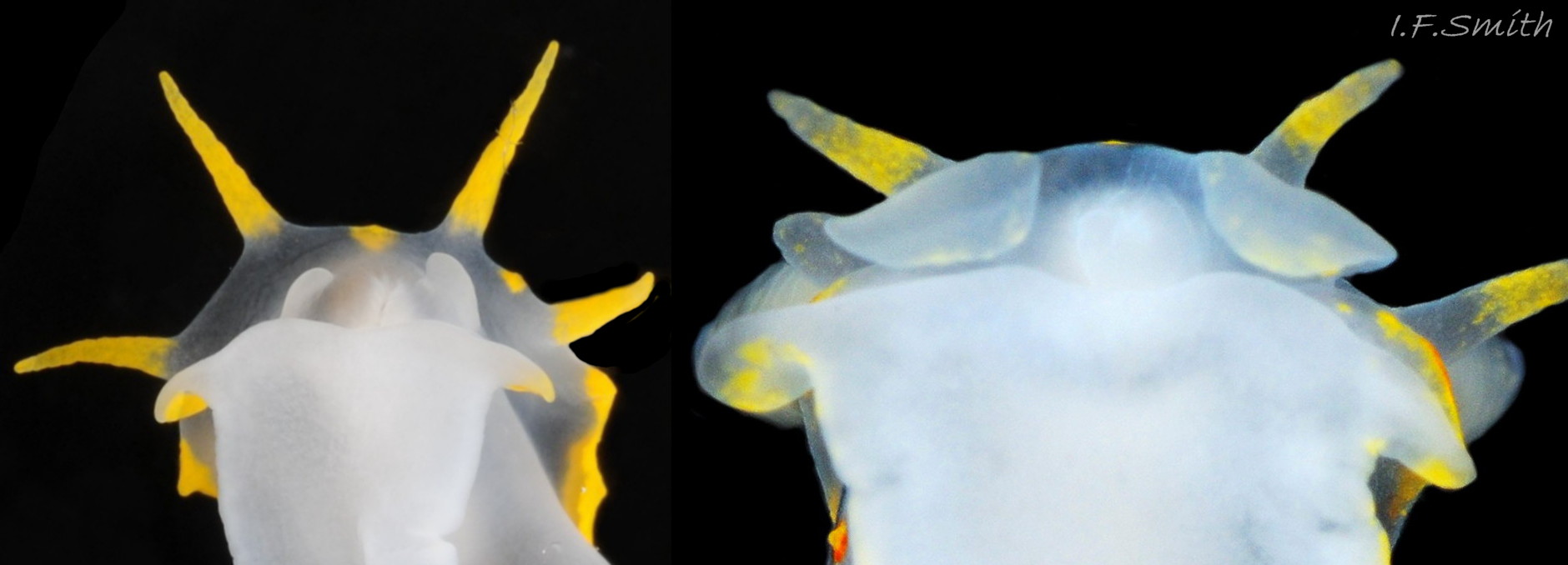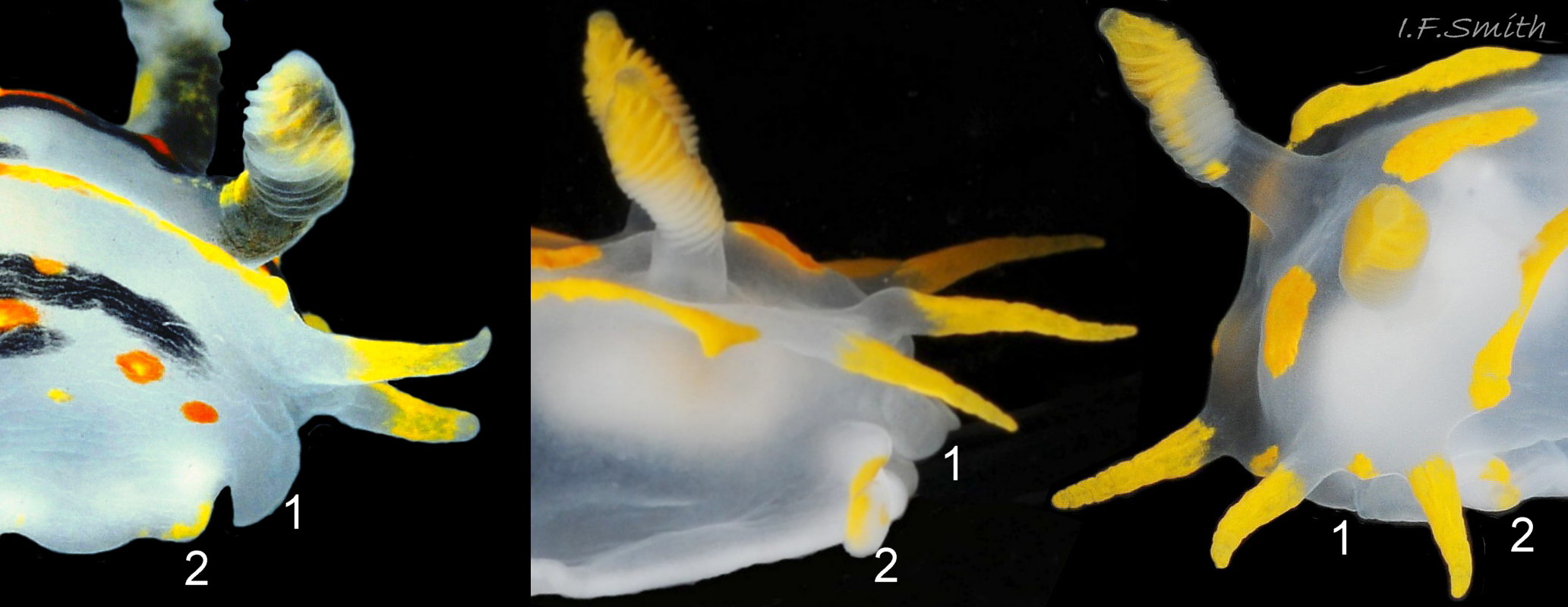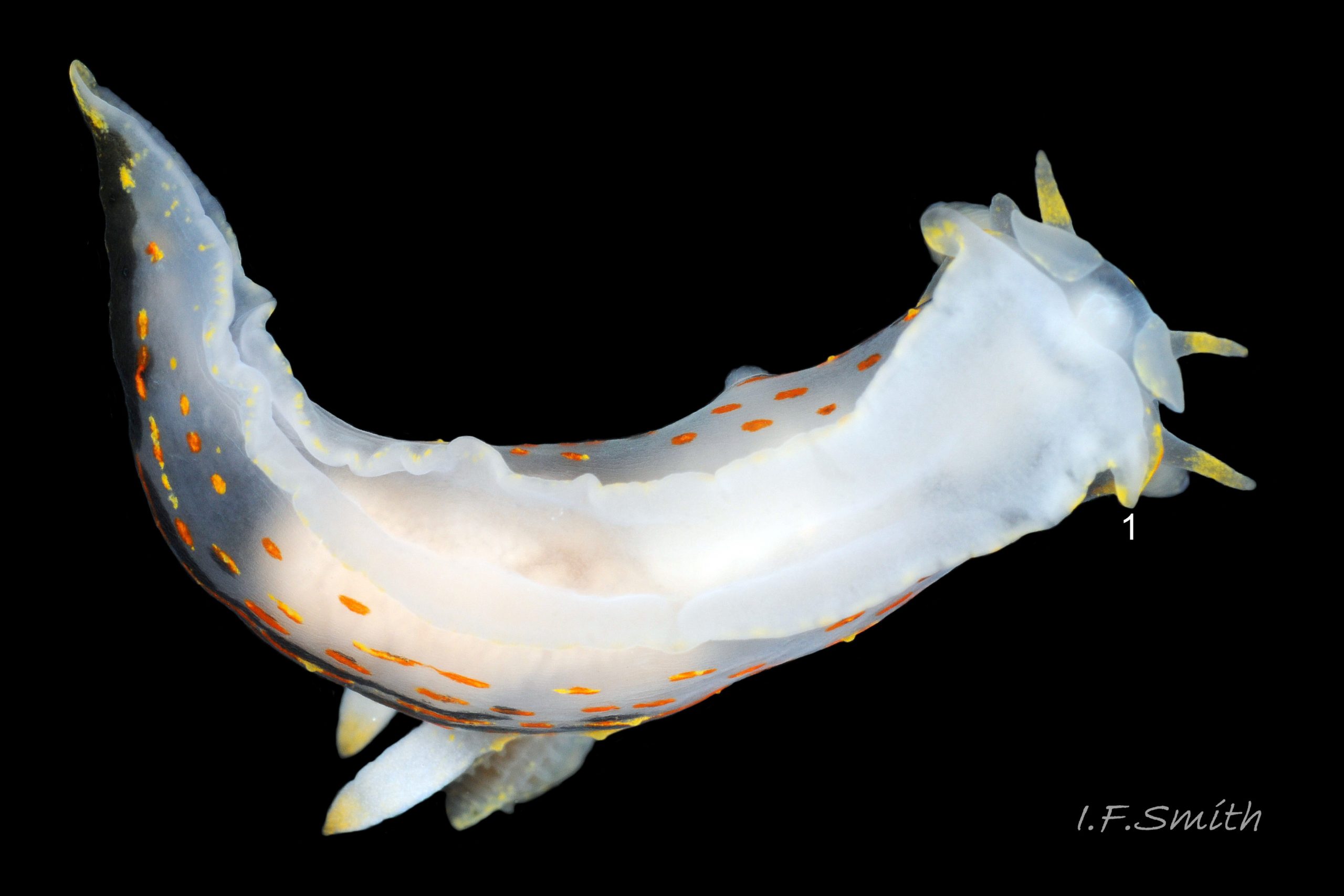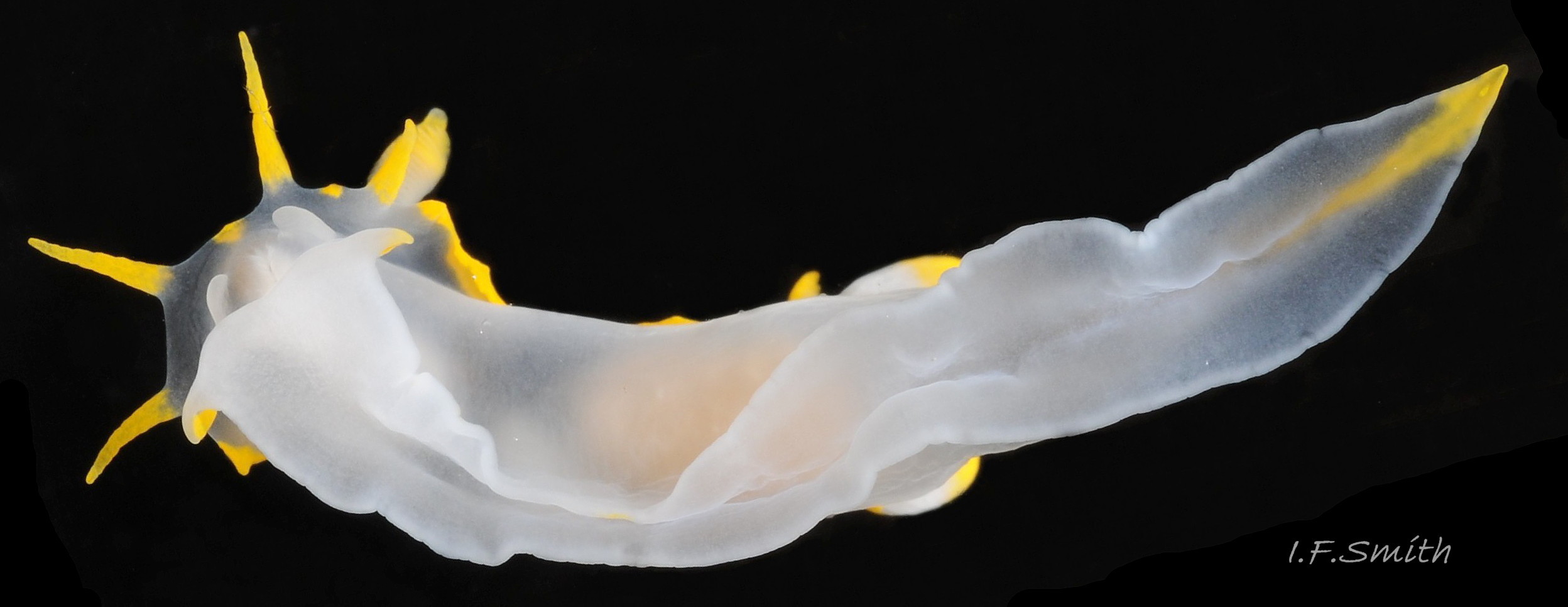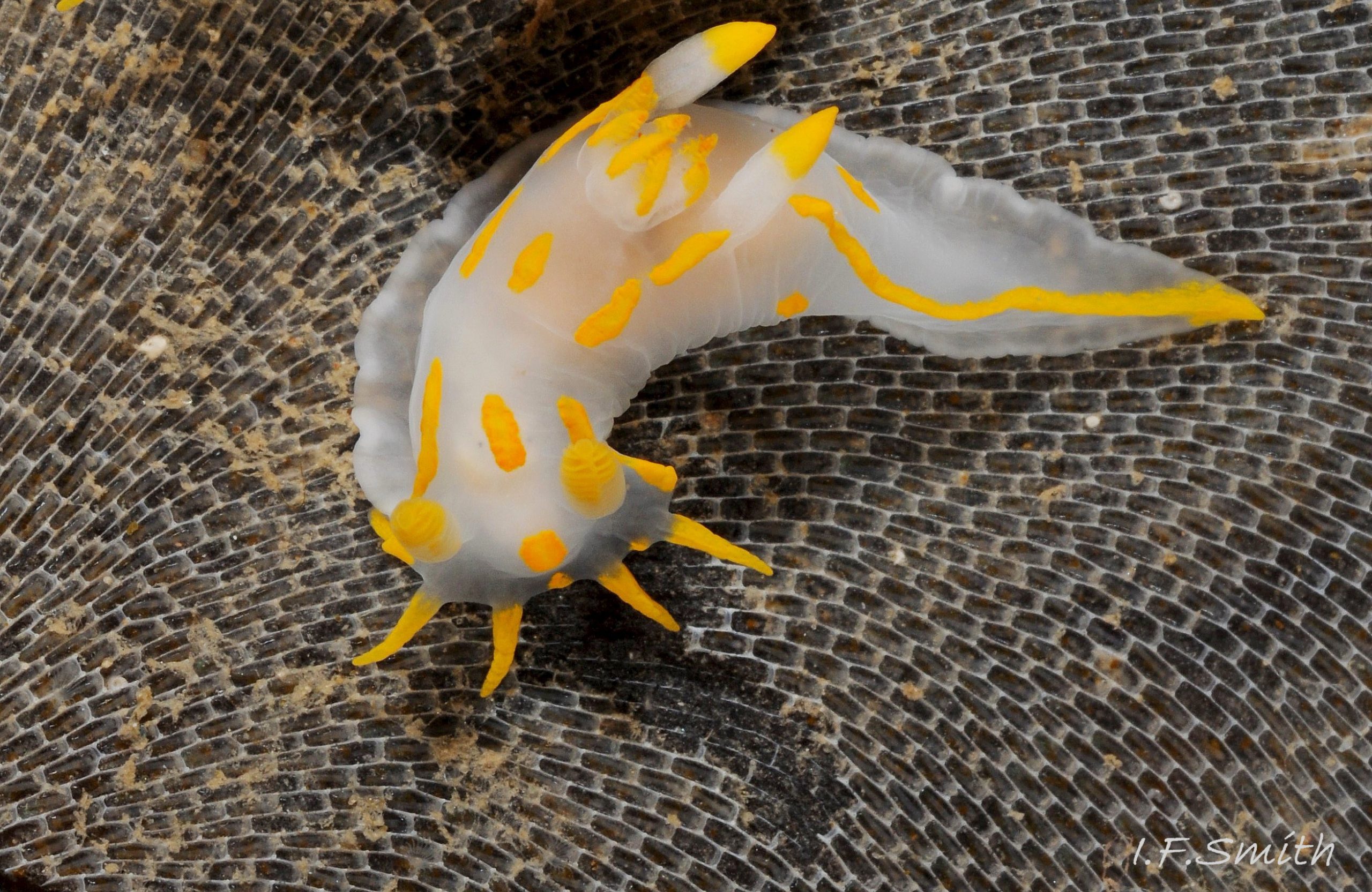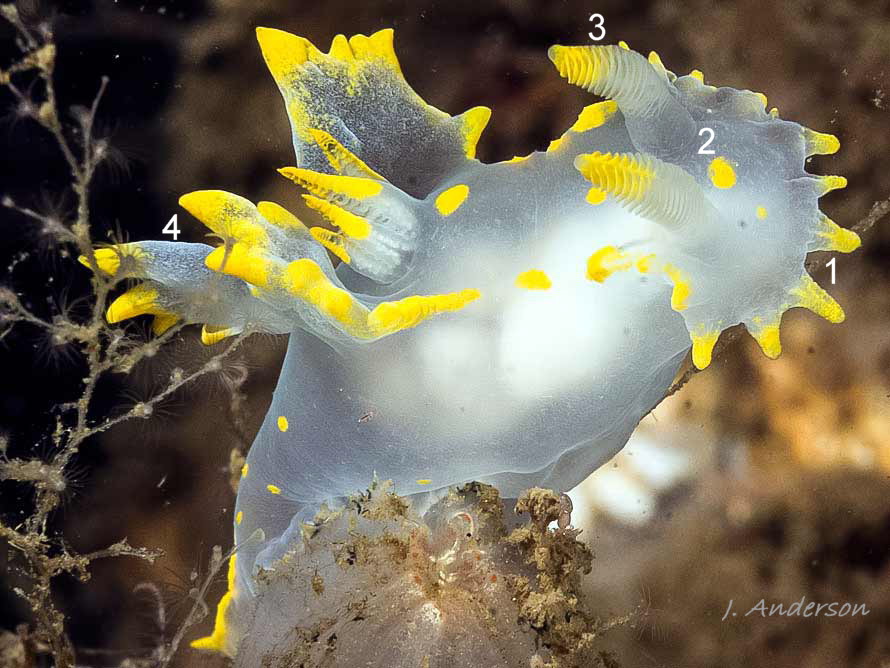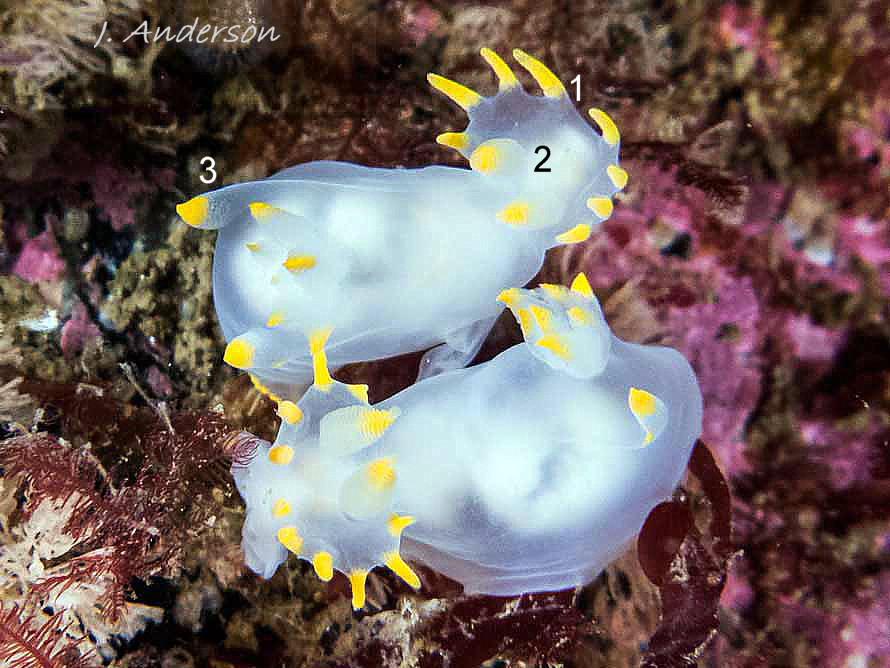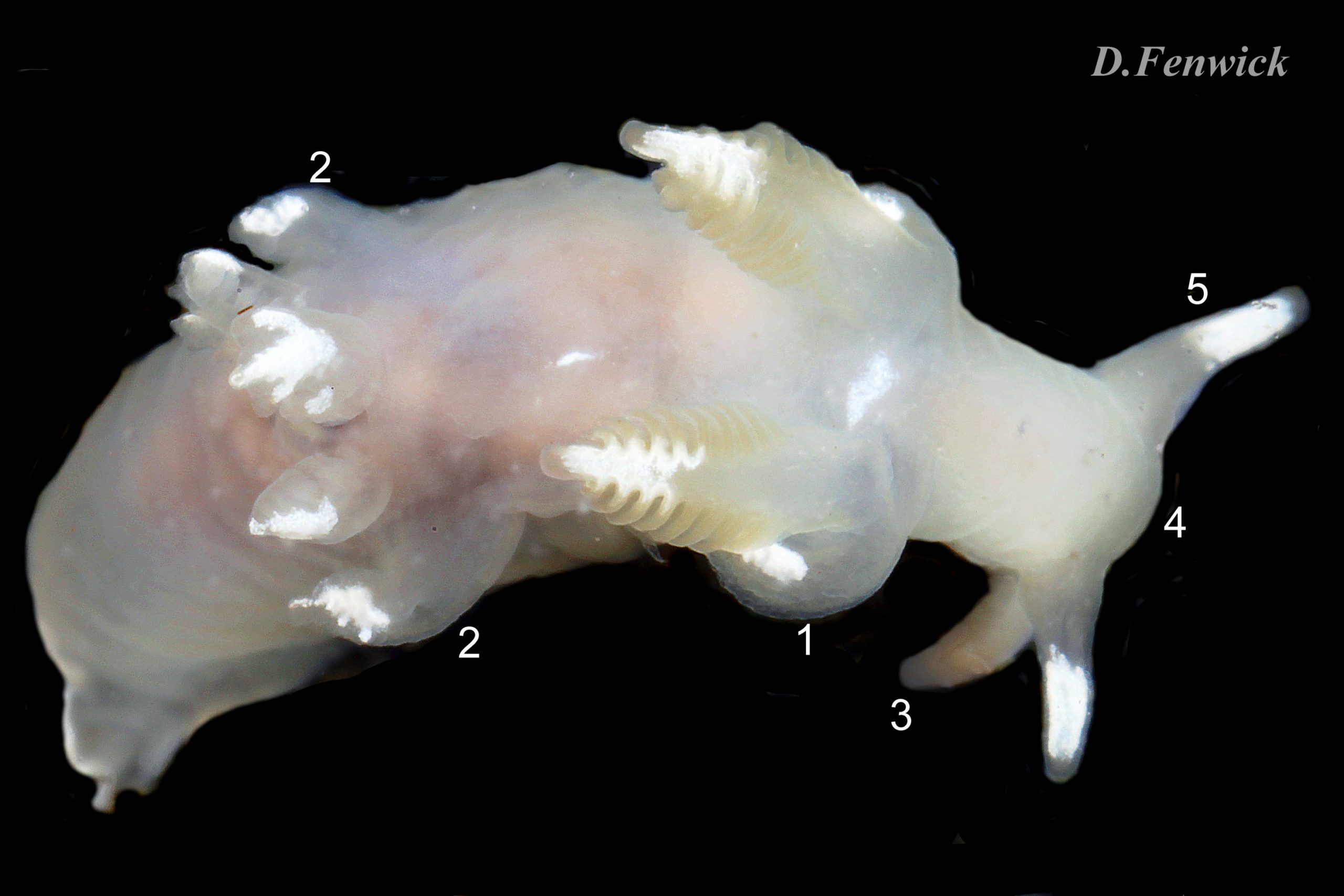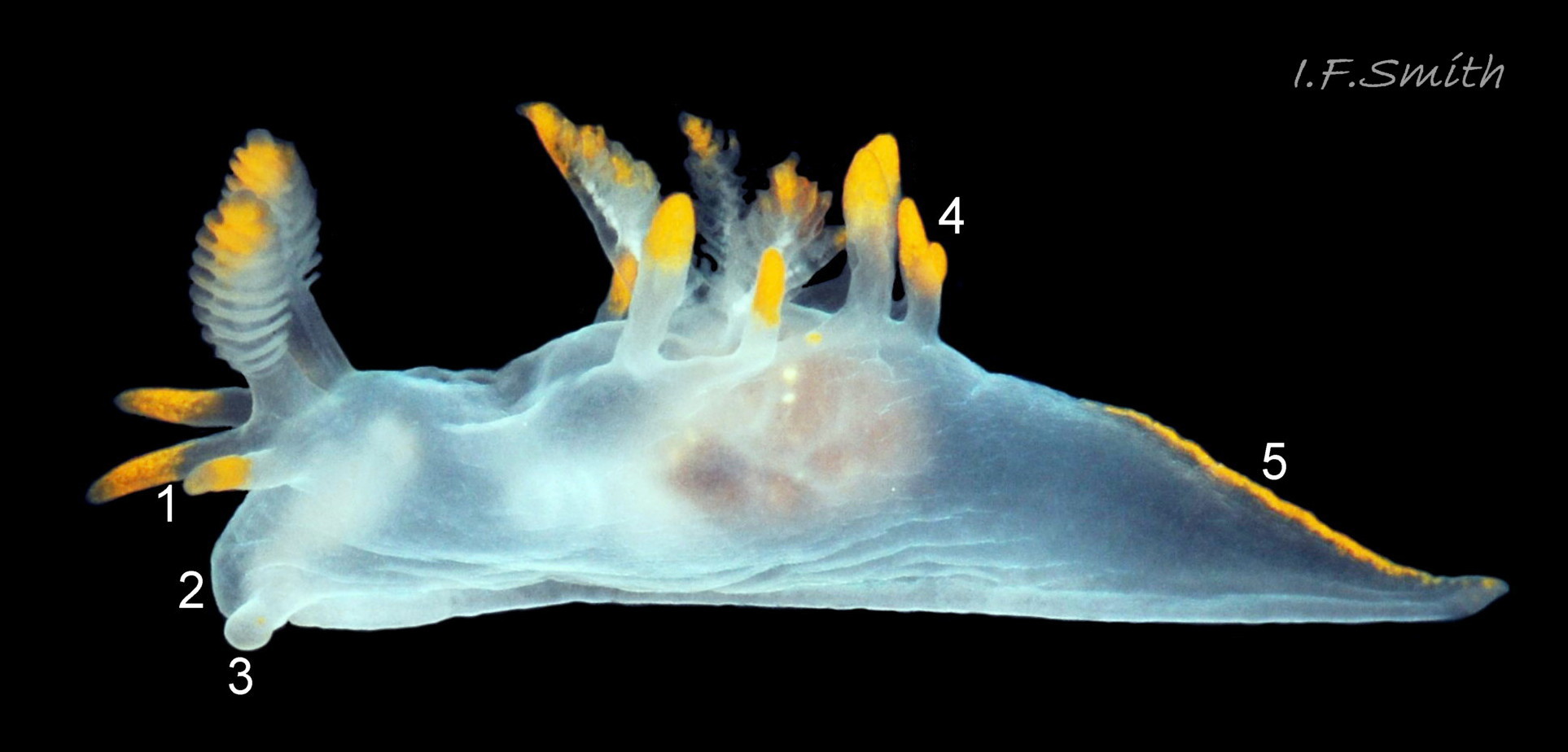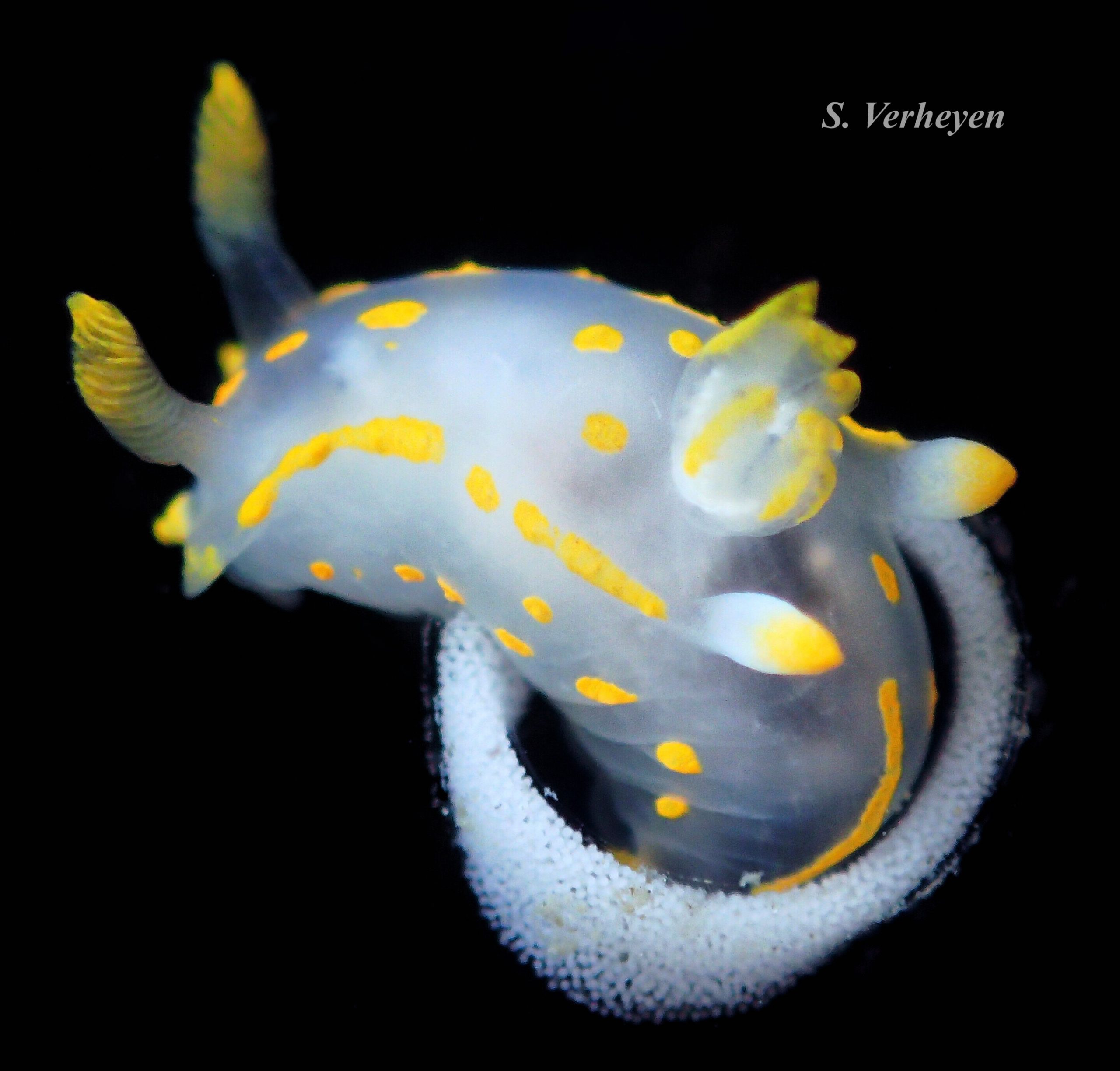Click image to enlarge with full caption. Main text below slider.
Polycera quadrilineata (O. F. Müller, 1776)
Current taxonomy: World Register of Marine Species
www.marinespecies.org/aphia.php?p=taxdetails&id=140838
Until 2020 Polycera norvegica Sørensen, Rauch, Pola & Malaquias, 2020 was included within most published descriptions of P. quadrilineata.
Synonyms: Doris quadrilineata O. F. Müller, 1776; Polycera lineatus Risso, 1826; Polycera mediterranea Bergh, 1879;
GLOSSARY BELOW
Description
P. quadrilineata grows up to a maximum of about 30 mm long, extreme maximum 45 mm reported in literature (Sørensen et al., 2020). The body is translucent white, often revealing a dull orange or pinkish digestive gland below the gills, and a white buccal mass below the rhinophores 01 Polycera quadrilineata . Its appearance varies with extension/contraction of its body and appendages 01 Polycera quadrilineata & 02 Polycera quadrilineata . The smooth surface has orange or yellow tuberculate blotches marking the rim of the reduced mantle in a line from below the rhinophores to the large single lobe at each side of the gills 01 Polycera quadrilineata . The anterior of the rim often has triangular lateral projection 03 Polycera quadrilineata which sometimes is elongated and can be mistaken for a process on the anterior veil.
Almost all P. quadrilineata have yellow or orange on their appendages, on a dorsal line on the tail and on a variable number and size of scattered tuberculate blotches (not fine specks) 03 Polycera quadrilineata . In addition to the orange or yellow marks some have a few blackish marks (not fine specks) especially on the stems of the rhinophores 04 Polycera quadrilineata & 05 Polycera quadrilineata . Other specimens have much more black pigment in lines 06 Polycera quadrilineata which sometimes resemble pin stripe 07 Polycera quadrilineata and sometimes merge and mask the yellow or orange dorsal line on the tail 08 Polycera quadrilineata . The frequency of different colour combinations varies at different locations and with growth; the darker colours developing with age.
On the side of the animal, half way between the right rhinophore and gill there is a white genital aperture, most easily seen when in a contrasting black area 09 Polycera quadrilineata . It sometimes has the white penis partially extended 10 Polycera quadrilineata .
The rhinophores have a smooth, transparent, unpigmented basal third. The upper two thirds have a mean of 10 to 12, range 6 to 17 lamellae (Sørensen et al. 2020 modified with data in Korshunova et al. 2021); the lower ones are incomplete 01 Polycera quadrilineata & 03 Polycera quadrilineata . The middle third of the rhinophore often flexes backwards, and the distal third flexes forwards. The distal lamellae usually have yellow or orange pigment which extends a variable amount down the anterior leaving the posterior translucent white. Some rhinophores have black pigment 07 Polycera quadrilineata , especially on the smooth basal third 04 Polycera quadrilineata .
On the posterior slope of the swelling over the pericardium 09 Polycera quadrilineata , which usually forms the highest point of the body, there is a fan of six or seven, sometimes up to eleven, unipinnate gill plumes 11 Polycera quadrilineata . The anal papilla is located at the posterior of the fan’s base 10 Polycera quadrilineata , 11 Polycera quadrilineata & 12 Polycera quadrilineata . On specimens with little or no dark pigment on the body, the gills are usually translucent white with yellow or orange tips 01 Polycera quadrilineata , 04 Polycera quadrilineata & 12 Polycera quadrilineata .Those with black on the body usually have darker colours such as brown on the shaft of the plumes 10 Polycera quadrilineata & 11 Polycera quadrilineata and dark shading on the vanes 09 Polycera quadrilineata & 11 Polycera quadrilineata . The gills do not retract into a pit, but they can contract into a small tight clump around the anal papilla 12 Polycera quadrilineata or fold back over it 13 Polycera quadrilineata .When defecating, the fan can be held vertically to avoid fouling of the gills 10 Polycera quadrilineata .
The edge of the mantle over the head is extended into an anterior veil with four or five, maximum seven, elongate yellow or orange processes 03 Polycera quadrilineata & 06 Polycera quadrilineata . On either side of the rounded oral area there is steep sided, oral rib which becomes a broad tapered structure when the mouth is pushed forward, level with or beyond the anterior veil 14 Polycera quadrilineata & 15 Polycera quadrilineata .
The translucent white sole of the foot is truncate and broadest at the anterior with yellow-tipped, propodial tentacles 16 Polycera quadrilineata . It tapers to a pointed posterior and readily folds along the midline 17 Polycera quadrilineata . The dorsal, yellow or orange, medial line on the tail shows through the sole. Dorsally the foot is translucent white, often with a few small yellow marks 09 Polycera quadrilineata .Viewed dorsally, the foot may be concealed by the body 03 Polycera quadrilineata , or may spread laterally into view 18 Polycera quadrilineata .
Key identification features
P. quadrilineata
1) Most frequent lengths, (66%), 6 mm to 12.9 mm, max. 26 mm, in 30 measured in Korshunova et al. (2021). 45 mm max. reported in literature (Sørensen et al. 2020).
2) All have yellow/orange blotches 03 Polycera quadrilineata , and some also have blackish lines or marks (not just fine specks) 06 Polycera quadrilineata.
3) Anterior veil has, mean 4 or 5, max. 7 elongate processes 03 Polycera quadrilineata .
4) No elongate papillae protruding from base of rhinophores.
5) Lamellae on rhinophore: mean 10 to 12, range 6 to 17 (Sørensen et al. 2020 modified with data in Korshunova et al. 2021) 03 Polycera quadrlineata .
6) Single large, elongate, inclined backwards, yellow tipped process on either side of gills 01 Polycera quadrilineata .
7) Oral rib becomes a broad tapered structure when the mouth is pushed forward 14 Polycera quadrilineata (Caution, feature 7 observed on single specimen)
Similar species
Polycera norvegica Sørensen, Rauch, Pola & Malaquias, 2020 19 Polycera quadrilineata and 20 Polycera quadrilineata
1) Most frequent lengths, (69%), 5 mm to 7.9 mm, max.16 mm, in 32 measured in Korshunova et al. (2021).
2) Some 19 Polycera quadrilineata have yellow/orange blotches like P. quadrilineata. Some 20 Polycera quadrilineata have a dense or sparse scatter of fine, blackish and/or brown specks (not strong black lines or blotches).
3) Anterior veil has mean of 4 or 5, maximum 6, elongate processes.
4) No elongate papillae protrude from base of rhinophores.
5) Lamellae on rhinophore: mean 8, range 6 to 11 (Sørensen et al. 2020 modified with data in Korshunova et al. 2021).
6) Single process either side of gills, often tipped yellow or a shade of orange darker than other yellow marks.
7) Oral rib becomes an un-tapered rounded structure when the mouth is pushed forward 19 Polycera quadrilineata. (Caution, feature 7 observed on single specimen).
Polycera faeroensis Lemche, 1929 21 Polycera quadrilineata.
1) Maximum length 45 mm.
2) Yellow markings often only on appendages and dorsal line on tail. Some have yellow marks on body. None have blackish lines or marks.
3) Anterior veil has occasionally 6, but mean 8 or 9, maximum 14, elongate processes.
4) No elongate papillae protruding from base of rhinophores.
5) Lamellae on rhinophore: mean 18 to 19, maximum 25.
6) Compound lobe/flap with several summits/tubercles on either side of gills.
Polycera kernowensis Driessen, Picton & Martynov, 2021 22 Polycera quadrilineata.
1) Maximum length 20 mm.
2) Yellow markings confined to appendages and dorsal line on tail; no other coloured markings.
3) Anterior veil has mean 7 or 8, maximum 9, elongate processes.
4) No elongate papillae protruding from base of rhinophores.
5) Lamellae on rhinophore: mean 14 to 15, maximum 22.
6) Single process either side of gills, sometimes yellow tipped,
Trapania maculata Haefelfinger, 1960, T. pallida Kress, 1968 23 Polycera quadrilineata & T. tartanella (Ihering, 1886) 24 Polycera quadrilineata
2) White bodies with some opaque white, yellow or orange markings on some.
3) No elongate processes on anterior edge of head.
4) 1 or 2 backward pointing elongate papillae at base of each rhinophore.
6) Single elongate papilla on either side of the gills.
Ancula gibbosa (Risso, 1818) 25 Polycera quadrilineata
1) Maximum length usually about 13 mm.
2) Yellow markings confined to appendages and dorsal line on tail; no other coloured markings.
3) No elongate processes on anterior edge of head (but has white oral tentacles).
4) 2 forward pointing elongate papillae at base of each rhinophore (can be mistaken for an anterior veil when viewed from above).
5) About 8 to 10 lamellae on rhinophore.
6) Several erect elongate papillae on either side of the gills.
Habits and ecology
P. quadrilineata lives at lower levels on rocky shores and sublittorally to 60 m. In North Wales it is usually largest and most easily found in February and March. It feeds on encrusting bryozoans, including Electra pilosa (often on Fucus serratus), Membranipora membranacea (often on Laminaria) 18 Polycera quadrilineata , Callopora dumerilii, Celleporella hyalina and Tegella unicornis (Thompson and Brown, 1984).
It is a simultaneous hermaphrodite. The short, curved ribbon of spawn 26 Polycera quadrilineata is attached by its edge near or on its prey on Fucus and Laminaria fronds and other algae in most months. Each mass contains about 20 000 small ova (Thompson & Brown, 1984). Shelled veliger larvae live as plankton before metamorphosing.
Distribution and status
P. quadrilineata occurs from arctic Norway to the Mediterranean, GBIF map www.gbif.org/species/2291758 . The GBIF map will include many records of mis-identified P. norvegica made before its segregation was accepted. It is common, and sometimes abundant in early spring, on hard substrate shores all around Britain and Ireland, U.K. map,NBN, species.nbnatlas.org/species/NHMSYS0021316697 and many records lacking available images within the aggregate P. quadrilineata/norvegica, made before 2020 when the segregation was accepted, are at species.nbnatlas.org/species/NHMSYS0021494705
Acknowledgements
I am indebted to Jim Anderson, David Fenwick and Stefan Verheyen for their generous provision of images for use in this account.
References and links
Alder, J. & Hancock, A. 1854. Notice of some new species of British Nudibranchiata. Ann. Mag. Nat. Hist. Second series vol 14, No. 79. pp.102–105 (1854) www.biodiversitylibrary.org/page/2283472 [Polycera capitata as Thecacera capitata].
Alder, J. & Hancock, A. 1845-1855. A monograph of the British nudibranchiate mollusca. London, Ray Society. Fam. 1 Pl. 22 www.biodiversitylibrary.org/item/131598#page/200/mode/1up
Anderson, J. (accessed March, 2022), Scottish Nudibranchs www.nudibranch.org/Scottish%20Nudibranchs/
Fenwick, D. (accessed March, 2022) Aphotomarine www.aphotomarine.com/
Korshunova, T.A., Driessen, F.M.F., Picton, B.E. & Martynov, A.V. 2021. The multilevel organismal diversity approach deciphers difficult to distinguish nudibranch species complex. Sci Rep 11, 18323 (2021). doi.org/10.1038/s41598-021-94863-5
Supplementary information
static-content.springer.com/esm/art%3A10.1038%2Fs41598-02…
Malaquias, M., Sørensen, C., Rauch, C., & Pola, M. (2022). Polycera norvegica is a valid species, and a plea for good taxonomic practices – a reply to Korshunova et al., 2021. Journal of the Marine Biological Association of the United Kingdom, 1-3. www.researchgate.net/publication/359931143_Polycera_norve…
Sørensen, C.G., Rauch, C., Pola, M. and Malaquias M.A.E. 2020. Integrative taxonomy reveals a cryptic species of the nudibranch genus Polycera (Polyceridae) in European waters. J. Mar. Biolog. Assoc. U.K. 1–20. Polycera capitata (Alder & Hancock, 1854) as P. norvegica sp. nov. doi.org/10.1017/S0025315420000612
also at
www.researchgate.net/publication/343321671_Integrative_ta…
Thompson, T.E. & Brown, G.H. 1984. Biology of opisthobranch molluscs 2. London, Ray Society.
Current taxonomy: World Register of Marine Species www.marinespecies.org/aphia.php?p=taxdetails&id=140838
Glossary
appendages = rhinophores, gills, lobes on anterior veil and lobes by gills.
buccal mass = organ system which includes the odontophore, radula, and a complex of muscles to operate them.
digestive gland = organ which acts like the liver and pancreas in mammals to absorb food.
dorid = a sea slug in the infraorder Doridoidei; with dorsal gills and rhinophores.
hermaphrodite, simultaneous = individual acts as both male and female at same time.
lamellae = (of sea slugs) small plates on rhinophores or leaflets of gill.
mantle = (of nudibranchs) sheet of tissue forming part or all of dorsal body surface.
anterior veil = anterior extension of mantle into a protruding sheet.
papilla = (pl. papillae) small, nipplelike protruberance.
pericardium = membranous sac containing heart.
propodium = anterior portion of gastropod foot. (adj. propodial).
rhinophore = chemo-receptor tentacle; many sea slugs have a pair on top of the head.
unipinnate = branching singly; boughs but no subsequent branches, like a feather.
veliger = shelled larva of marine gastropod or bivalve mollusc which moves by action of cilia on a velum (bilobed flap). Stage may be passed in plankton or within liquid-filled egg-capsule.
